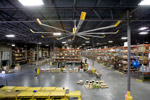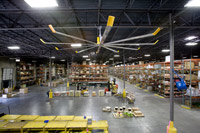
Going with the Airflow
Studies indicate worker productivity decreases as temperatures rise above 77 degrees Fahrenheit.
- By Nina Wolgelenter
- May 14, 2010
 People can tolerate extremes of hot and cold but tend to be more productive within a narrow range of conditions. An uncomfortable working environment unwittingly affects employee morale, playing a large role in the health and safety of those within. Likewise, manufacturing plants are notorious for fluctuating temperatures, and equipment is only as good as the people who operate it. When conditions within a facility are no longer favorable, worker productivity inevitably takes a nose dive — bringing profits down as well.
People can tolerate extremes of hot and cold but tend to be more productive within a narrow range of conditions. An uncomfortable working environment unwittingly affects employee morale, playing a large role in the health and safety of those within. Likewise, manufacturing plants are notorious for fluctuating temperatures, and equipment is only as good as the people who operate it. When conditions within a facility are no longer favorable, worker productivity inevitably takes a nose dive — bringing profits down as well.
Comfort comes in a variety of forms, from air conditioning to natural ventilation or increased air movement from large circulator fans, with some options obviously more costly than others. "The airflow from large-diameter, low-speed fans provides a comforting effect which increases worker comfort, productivity, and accuracy, positively impacting the bottom line," said Christian Taber, applications engineer and LEED®-accredited professional for Big Ass Fans®, a Lexington, Ky.-based manufacturer of industrial cooling equipment.
Hot working conditions affect worker morale, absenteeism, turnover, quality of workmanship, and the frequency of both accidents and grievances.
Fortunately, there is a middle ground between surrendering to the expense of air conditioning and suffering a continual loss of profits due to comfort-related problems. According to the Center for the Built Environment, temperature, air quality, and noise level are the three most important factors when considering productivity.
1 In addition, sustainability is increasingly important to facility managers.
The key to the effectiveness of large-diameter, low-speed fans is the huge volume of air generated by the fans' ten patented hollow-core airfoils with winglets. The winglets are designed to help lift air up and over obstructions, including massive machinery and racking, enabling airflow to reach all occupants. OSHA standards indicate temperatures of 100.4 degrees Fahrenheit and above are dangerous for workers, while air temperatures that exceed 95 degrees F significantly increase the heat load on the body.2 When temperature and humidity rise, the body's ability to cool itself decreases. The gentle, non‐disruptive, non‐turbulent airflow aids in the evaporative cooling process, which in turn reduces the chance of heatstroke.
Using airflow from large-diameter, low-speed ceiling fans to improve the overall environmental quality within warehouses allows for more constant, even temperatures that in turn combat localized humidity issues and the resulting mold growth that can exist, significantly improving indoor environmental quality concerns. In fact, studies have shown that occupant comfort leads to increased productivity, indicating worker productivity decreases as temperatures rise above 77 degrees F.3
Discomfort issues have a negative impact on productivity and the bottom line, and research shows that elevated temperatures affect our potential for both mental and physical work. Hot working conditions affect worker morale, absenteeism, turnover, quality of workmanship, and the frequency of both accidents and grievances. Considering the cost to cool a plant with air conditioning is high, there are effective alternatives that provide significant relief at far lower costs. In today's competitive economy, it pays to take a look.
References
1. Center for the Built Environment. "TechNotes: Productivity and IEQ Satisfaction."
2. Occupational Health and Safety Administration Technical Manual, Section III: Ch. 4; Heat Stress. 1999.
3. Seppänen O, Fisk WJ, Faulkner D. 2003. Cost benefits analysis of the night-time ventilative cooling. In: Proceedings of the Healthy Buildings 2003 Conference, Singapore 2003.